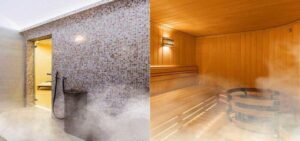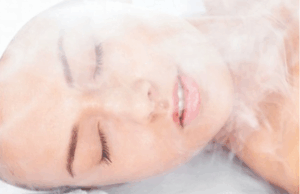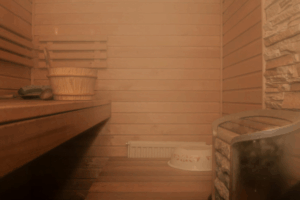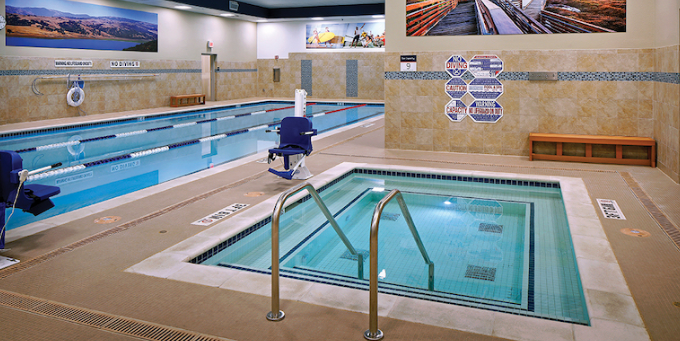Between the Sauna vs Steam Room, our Sunasusa team believes that the sauna is better for the skin since it encourages sweating, which opens pores and assists with detoxification, leaving my skin feeling renewed and revitalized. Saunas and steam rooms have many advantages, some beneficial to the skin.
Both can enhance the health of your skin, but steam rooms are usually better for dry skin since they contain humidity, which helps hydrate the skin. On the other hand, indoor saunas cause excessive perspiration in a dry and hot atmosphere, which may irritate the skin, especially in people who already have skin issues.
Table of Contents
Sauna vs Steam Room

Steam rooms offer lower temperatures, often between 110°F and 120°F (43°C to 49°C) with significant humidity levels, baths give dry air at greater temperatures, often between 160°F to 200°F (70°C to 100°C). Steam rooms are better for people with skin disorders or respiratory problems since they are gentle on the skin, hydrating and opening pores.
In contrast, spas encourage heavy perspiration and could provide superior detoxifying advantages; nevertheless, some people may find the dry heat uncomfortable, and if they don’t drink enough water, they risk being dehydrated. The decision between a sauna and a steam room ultimately comes down to personal taste and particular health objectives.
Benefits of steam rooms for skin

The advantages of steam rooms for skin may be simplified into these steps:
- Moisturizes the Skin: Steam rooms’ high humidity levels contribute to the skin’s general hydration levels and prevent dryness.
- Opens Pores: By moisturizing the skin, steam rooms facilitate the easier evacuation of toxins, oil, and dust from the skin, which may help ward against blackheads and acne.
- Cleanses the Skin: The moisture and heat in steam rooms encourage perspiration, which helps to rid the skin of toxins and impurities.
- Improves Blood Flow: Steam rooms encourage blood flow, which nourishes and oxygenates skin cells, improving skin health and resulting in a glowing complexion.
- Relieves Skin Problems: By relieving irritation and decreasing inflammation, hot tubs can help treat several skin problems, including skin irritation, psoriasis, and itch.
- Encourages Relaxation: The pleasant temperature and steam from steam spaces aid in relieving tension and relaxing muscles, which lowers stress levels and may benefit skin health.
Benefits of sauna for skin
Here are the advantages of saunas for the skin:
- Promotes Sweating: Spas encourage intense perspiration, which helps the skin rid itself of pollutants and toxins for a brighter complexion.
- Opens Pores: The heat from baths causes pores to open, which facilitates the elimination of debris, oil, and dead skin cells and helps lessen the appearance of acne and blackheads.
- Improves Circulation: Saunas enhance skin tone and elasticity by increasing blood flow to the skin, which provides oxygen and vital nutrients to skin cells.
- Scrubs the Skin: Heat and steam provide a natural exfoliation that can help reveal smoother, healthier-looking skin by removing dead skin cells.
- Stress Reduction: Saunas promote relaxation, which lowers stress levels and can benefit skin health by lowering inflammation and eliminating stress-related breakouts.
- Enhances Skin Texture: Consistent bathhouse usage can enhance skin texture, giving the appearance of softer, smoother, and younger skin.
All things considered, baths provide several advantages for skin health, such as stress reduction, increased circulation, detoxification, and cleaning.
Risks of Sauna or Steam room for skin

A step-by-step breakdown of the skin-related dangers of saunas or steam rooms:
- Dehydration: Excessive sweating in baths without adequate water can result in dehydration, which can cause dry skin and other health problems.
- Skin Irritation: While steam rooms can be uncomfortable for certain people if the level of moisture is too high, saunas with dry heat can irritate sensitive skin and cause problems like pimples or allergies.
- Heat Rash: Spas and hot tubs can also aggravate heat rash, particularly if extended use results in excessive perspiration and skin friction.
- Infections: In badly kept steam rooms or saunas, the risk of wounds is increased because bacteria grow well in warm, humid conditions.
- Dilated Blood Vessels: Extended exposure to high temperatures can cause dilated blood vessels, which can exacerbate redness symptoms or give the impression of flushing.
- Eye Irritation: Saunas’ dry heat can aggravate dry eyes or pain in certain people, while steam rooms’ high humidity levels might irritate the eyes.
To reduce the hazards related to bath and steam room use, it’s important to exercise in moderation, keep hydrated, and pay attention to your body’s signals.
Sauna vs Steam Room: Which is better for your skin?
Seam rooms are often regarded as superior to baths since they moisturize the skin instead of dehydrating it. The moist heat of steam rooms hydrates your skin and promotes cleaning. Spas and steam rooms both induce perspiration, which hydrates the skin; however, steam rooms are more likely to do so.
Before utilizing a hot tub or steam room, you must see a physician with dermatology if you have a health problem or skin issue. People who have skin disorders like eczema should exercise caution since these facilities may have unfavorable impacts. However, they may also be beneficial for skin health.
Sauna vs Steam Room: To Get Rid of Blackheads
Although steam rooms are often chosen because they may offer skin hydration, saunas can also aid in the removal of blackheads. The moisture in steam rooms relaxes pores, moisturizes the skin, and facilitates the removal of dirt and oil, all of which can minimize blackheads.
By encouraging sweat and opening pores, hot tubs can also help remove blackheads, but for certain skin types, the lack of moisture may be less beneficial and even more irritating. Because steam rooms are hydrating, some could find them more helpful for getting rid of blackheads. Nonetheless, to ascertain the optimal course of action given specific skin requirements and sensitivities, it is imperative to speak with a dermatologist.
Shower after the sauna or steam room
Showering is advised to remove perspiration and dead cells from your body after using a sauna or steam room. After detoxification, this stage is crucial for guaranteeing a complete cleaning and getting rid of unwanted contaminants. It’s advised to moisturize your body very much after taking a shower to restore reduced moisture and preserve skin health.
Conclusion
Personal tastes and skin requirements play a major role in determining which environment is best for your skin between Sauna vs Steam Room. Because steam rooms may hydrate the skin, they often provide a greater advantage regarding skin benefits.
Steam rooms’ high humidity levels moisturize skin and improve cleansing. Spas can help the skin by encouraging sweating and cleaning pores; however, some skin types may find the dry heat uncomfortable. In the end, using a hot tub or steam room can help people have healthier skin, although some may find steam rooms preferable, especially if they have fragile or dry skin.
FAQs
The most frequently asked questions are given below:
Are steam rooms moisturizing?
According to Hart’s theory, the moisturizing effects of the warm, humid air will saturate skin with moisture instead of drying it. Additionally, the heat and humidity may help both unclog and cleanse oily, acne-prone skin.
Is a steam room good for skin conditions?
Sweating facilitates pore opening and external skin cleansing. Warm condensation may aid in the treatment of acne by rinsing away dust and dead skin. A steam room also aids in eliminating toxins that are trapped behind the skin.
Can a steam room help acne?
People with acne-prone skin can benefit most from steam rooms since they can help reduce the inflammation and irritation that problems create. As the steam heats up, it facilitates the opening of pores and the removal of pollutants, and it also promotes healing and regeneration through improved circulation.







